
- Homepage
- Composition
- Denomination
- Ae Prutah (34)
- Ae3 (14)
- Antoninianus (104)
- Ar Denarius (42)
- Aurelianianus (12)
- Aureus (145)
- Bi Double Denarius (24)
- Bi Nummus (22)
- Centenionalis (16)
- Cistophorus (24)
- Denarius (1272)
- Double Denarius (63)
- Dupondius (16)
- Nummus (119)
- Prutah (27)
- Quadrigatus (13)
- Sestertius (127)
- Siliqua (15)
- Solidus (169)
- Tetradrachm (21)
- Other (604)
- Era
- Grade
- Ruler
- Antoninus Pius (53)
- Augustus (141)
- Caracalla (53)
- Constantine I (57)
- Constantine Ii (29)
- Domitian (58)
- Gallienus (37)
- Gordian Iii (62)
- Hadrian (100)
- Marcus Aurelius (69)
- Nero (113)
- Nerva (31)
- Philip I (66)
- Septimius Severus (36)
- Severus Alexander (69)
- Theodosius Ii (32)
- Tiberius (69)
- Trajan (97)
- Trajan Decius (28)
- Vespasian (76)
- Other (1607)
- Year
BASILISCUS & MARCUS Authentic Ancient 475AD GOLD Roman Coin RARE NGC i81520
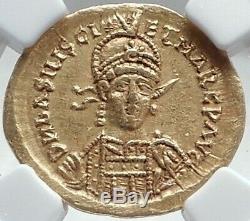
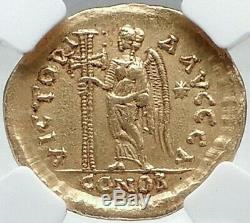
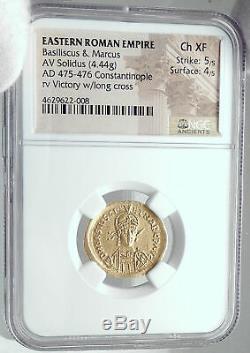
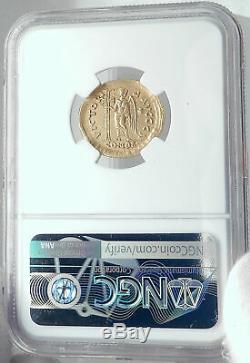
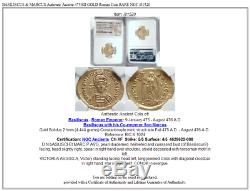


Item: i81520 Authentic Ancient Coin of. 9 January 475 - August 476 A. Basiliscus with his Co-emperor Son Marcus.
Gold Solidus 21mm (4.444 grams) Constantinople mint, struck late Fall 475 A. Reference: RIC X 1024 Certification: NGC Ancients. Ch XF Strike: 5/5 Surface: 4/5 4629622-008 D N bASILISCI-Et MARC P AVG, pearl-diademed, helmeted and cuirassed bust of Basiliscus? Facing, head slightly right, spear in right hand over shoulder, shield decorated with horseman motif in left. VICTORI-A AVGGG A, Victory standing facing, head left, long jeweled cross with diagonal crossbar in right hand; star in right field, CONOB in exergue.
Marcus (son of Basiliscus) (Latin: Flavius Marcus Augustus) (died 476/477) was the son of the East Roman or Byzantine general and usurper Basiliscus and Zenonis. He was acclaimed Caesar in 475 and later promoted to Augustus, ruling as junior co-emperor to his father. When Zeno reoccupied Constantinople in late August 476, Marcus, with his parents, took refuge in a church.
Zeno promised not to spill their blood, so he exiled them to Limnae in Cappadocia and subsequently starved them to death. Basiliscus (Latin: Flavius Basiliscus Augustus ; Greek:) d. 476/477 was Byzantine Emperor from 475 to 476. A member of the House of Leo, he came to power when Emperor Zeno was forced out of Constantinople by a revolt. Basiliscus was the brother of Empress Aelia Verina, who was the wife of Emperor Leo I (457-474).
His relationship with the Emperor allowed him to pursue a military career that, after minor initial successes, ended in 468, when he led the disastrous Roman invasion of Vandal Africa, in one of the largest military operations of Late Antiquity. Basiliscus succeeded in seizing power in 475, exploiting the unpopularity of Emperor Zeno, the "barbarian" successor to Leo, and a plot organised by Verina that had caused Zeno to flee Constantinople. However, during his short rule, Basiliscus alienated the fundamental support of the Church and the people of Constantinople, promoting the Miaphysite christological position in opposition to the Chalcedonian faith. Also, his policy of securing his power through the appointment of loyal men to key roles antagonised many important figures in the imperial court, including his sister Verina. So, when Zeno tried to regain his empire, he found virtually no opposition, triumphantly entering Constantinople, and capturing and killing Basiliscus and his family.
The struggle between Basiliscus and Zeno impeded the Eastern Roman Empire's ability to intervene in the fall of the Western Roman Empire, which happened in early September 476. When the chieftain of the Heruli, Odoacer, deposed Western Emperor Romulus Augustus, sending the imperial regalia to Constantinople, Zeno had just regained his throne, and he could only appoint Odoacer dux of Italy, thereby ending the Western Roman Empire.
Likely of Balkan origin, Basiliscus was the brother of Aelia Verina, wife of Leo I. It has been argued that Basiliscus was uncle to the chieftain of the Heruli, Odoacer. This link is based on the interpretation of a fragment by John of Antioch (209.1), which states that Odoacer and Armatus, Basiliscus' nephew, were brothers. However, not all scholars accept this interpretation, since sources do not say anything about the foreign origin of Basiliscus.It is known that Basiliscus had a wife, Zenonis, and at least one son, Marcus. Basiliscus' military career started under Leo I. The Emperor conferred upon his brother-in-law the dignities of dux , or commander-in-chief, in Thrace.
In this country Basiliscus led a successful military campaign against the Bulgars in 463. He succeeded Rusticius as magister militum per Thracias (464), and had several successes against the Goths and Huns (466 or 467).
Basiliscus's value rose in Leo's consideration. Verina's intercession in favour of her brother helped Basiliscus' military and political career, with the conferral of the consulship in 465 and possibly of the rank of patricius.However, his rise was soon to meet a serious reversal. Disastrous expedition against the Vandals. Cap Bon, in modern Tunisia is the place where the Roman fleet led by Basiliscus landed to launch an attack upon the Vandal capital of Carthage. Further information: Battle of Cape Bon (468). In 468, Leo chose Basiliscus as leader of the famous military expedition against Carthage.
The invasion of the kingdom of the Vandals was one of the greatest military undertakings recorded in the annals of history, a combined amphibious operation with over ten thousand ships and one hundred thousand soldiers. The purpose of the operation was to punish the Vandal king Geiseric for the sacking of Rome in 455, in which the former capital of the Western Roman Empire was overwhelmed, and the Empress Licinia Eudoxia (widow of Emperor Valentinian III) and her daughters were taken as hostages. The plan was concerted between Eastern Emperor Leo, Western Emperor Anthemius, and General Marcellinus, who enjoyed independence in Illyricum. Basiliscus was ordered to sail directly to Carthage, while Marcellinus attacked and took Sardinia, and a third army, commanded by Heraclius of Edessa, landed on the Libyan coast east of Carthage, making rapid progress. It appears that the combined forces met in Sicily, whence the three fleets moved at different periods.
Ancient and modern historians provided different estimations for the number of ships and troops under the command of Basiliscus, as well as for the expenses of the expedition. Both were enormous; Nicephorus Gregoras speaks of one hundred thousand ships, the more reliable Cedrenus says that the fleet that attacked Carthage consisted of eleven hundred and thirteen ships, having each one hundred men on board. The most conservative estimation for expedition expenses is of 64,000 pounds of gold, a sum that exceeded a whole year's revenue. Sardinia and Libya were already conquered by Marcellinus and Heraclius, when Basiliscus cast anchor off the Promontorium Mercurii , now Cap Bon, opposite Sicily, about forty miles from Carthage. Geiseric requested Basiliscus to allow him five days to draw up the conditions of a peace. During the negotiations, Geiseric gathered his ships and suddenly attacked the Roman fleet. The Vandals had filled many vessels with combustible materials. During the night, these fire ships were propelled against the unguarded and unsuspecting Roman fleet. The Roman commanders tried to rescue some ships from destruction, but these manoeuvres were blocked by the attack of other Vandal vessels. Basiliscus fled in the heat of the battle. One half of the Roman fleet was burned, sunk, or captured, and the other half followed the fugitive Basiliscus.The whole expedition had failed. Heraclius effected his retreat through the desert into Tripolitania, holding the position for two years until recalled; Marcellinus retired to Sicily, where he was reached by Basiliscus; the general was, however, assassinated, perhaps at the instigation of Ricimer, by one of his own captains; and the king of the Vandals expressed his surprise and satisfaction, that the Romans themselves would remove from the world his most formidable antagonists. After returning to Constantinople, Basiliscus hid in the church of Hagia Sophia to escape the wrath of the people and the revenge of the Emperor. By the mediation of Verina, Basiliscus obtained the Imperial pardon, and was punished merely with banishment to Heraclea Sintica, in Thrace. In 471 and 472, Basiliscus helped Leo I to get rid of the Germanic influence in his court, helping in the murder of the Alan Magister militum Aspar.
The death of Aspar caused a revolt in Thrace, led by the Thracian Ostrogoth Theodoric Strabo, and Basiliscus was dispatched to suppress the revolt, something he successfully did with the aid of his nephew Armatus. In 474 he received the rank of caput senatus , "first among the senators". At the death of Leo, Zeno, who was a "barbarian" of Isaurian stock, but at the same time son-in-law of Leo, ascended to Emperor, after a short reign of his own son Leo II (474). The "barbarian" origins of the Emperor caused antipathy towards Zeno among the people of Constantinople. Furthermore, the strong Germanic portion of the military, led by Theodoric Strabo, disliked the Isaurian officers that Leo I brought to reduce his dependency on the Ostrogoths. Finally, Zeno alienated his fellow Isaurian general Illus, who was bribed by Basiliscus. In the middle of the conspiracy was Verina, who fomented a popular revolt against the Emperor. The uprising, supported by Theodoric Strabo, Illus and Armatus, was successful, and Verina convinced the Emperor to leave the city.Zeno fled to his native lands, bringing with him some of the Isaurians living in Constantinople, and the Imperial treasury. Basiliscus was then acclaimed as Augustus on 9 January 475 at the Hebdomon palace, by the palace ministers and the Senate. The mob of Constantinople got its revenge against Zeno, killing almost all of the Isaurians left in the city. In the beginning, everything seemed to go well for the new Emperor, who even tried to set up a new dynasty by conferring the title of Augusta upon his wife Aelia Zenonis and creating his son Marcus, Caesar , and later Augustus ; however, due to his mismanagement as emperor, Basiliscus quickly lost most of his supporters.
Corruption and the fire of Constantinople. The most urgent problem facing the new Emperor was the scarcity of resources left in the imperial treasury. Early in his reign, Constantinople suffered a massive fire, which destroyed houses, churches, and completely incinerated the huge library built by Emperor Julian. The fire was seen as a bad omen for the rule of Basiliscus. However, he quickly lost most of them. First, Basiliscus alienated his own sister Verina's support, executing the Magister Officiorum Patricius.Patricius was the lover of Verina, and the empress had planned to raise him to the imperial rank and to marry him: the very revolt against Zeno was organised to make Patricius emperor. Basiliscus, however, had out-witted his sister, and, after the flight of Zeno, had the ministers and the Senate choose him, and not Patricius, as Emperor. Basiliscus ordered the death of Patricius, as the officer was a natural candidate to overthrow the new Emperor; as a consequence, Verina later intrigued against Basiliscus, because of her lover's execution. Also, Theodoric Strabo, whose hatred of the Isaurian Zeno had compelled him to support Basiliscus' revolt, left the new Emperor's side. Basiliscus had in fact raised his own nephew Armatus, who was rumoured to be also the lover of Basiliscus' wife, to the rank of magister militum , the same that Strabo held.
Finally, the support of Illus was most likely wavering, given the massacre of the Isaurians allowed by Basiliscus. In that time, the Christian faith was shaken by the contrast between Miaphysites and Chalcedonians.
These were two opposing christological positions; the Chalcedonians claimed that Christ had both human and divine natures, while the Miaphysites claimed he had only one single united nature. The Council of Chalcedon, convoked by Emperor Marcian in 451, had ruled out Miaphysitism, with the support of the pope in the West and many bishops in the East.However, the Miaphysite position was still strong: the two Miaphysite Patriarchs Timothy Aelurus of Alexandria and Peter the Fuller of Antioch were deposed. From the beginning of his rule, Basiliscus showed his support for the Miaphysites.
Zacharias Scholasticus reports how a group of Egyptian Miaphysite monks, having heard of Emperor Leo's death, had moved from Alexandria to Constantinople to petition Zeno in favour of Timothy, but at their arrival in the capital, they found the newly elected Basiliscus instead. The Magister Officiorum Theoctistus, the former physician of Basiliscus, was the brother of one of the monks, so the delegation obtained an audience with Basiliscus, and, with the support of Theoctistus and of the Empress, they convinced Basiliscus to recall from exile the banished Miaphysite Patriarchs. Basiliscus re-instated Timothy Aelurus and Peter the Fuller to their sees, and by persuasion of the former issued (9 April 475) a circular letter (Enkyklikon) to the bishops calling them to accept as valid only the first three ecumenical synods, and reject the Council of Chalcedon. All bishops were to sign the edict.
While most of the Eastern bishops accepted the letter, Patriarch Acacius of Constantinople refused, with the support of the population of the city, clearly showing his disdain towards Basiliscus by draping the icons in Hagia Sophia in black. Soon after his elevation, Basiliscus had despatched Illus and his brother Trocundus against Zeno, who, now in his native fortresses, had resumed the life of an Isaurian chieftain. Basiliscus, however, failed to fulfill the promises he made to the two generals; furthermore, they received letters from some of the leading ministers at the court, urging them to secure the return of Zeno, for the city now preferred a restored Isaurian to a Miaphysite whose unpopularity increased with the fiscal rapacity of his ministers. During his operations in Isauria, Illus took Zeno's brother, Longinus, prisoner and kept him in an Isaurian fortress. Because he thought he would have great influence over a restored Zeno, he changed sides and marched with Zeno towards Constantinople in the summer of 476.
When Basiliscus received news of this danger, he hastened to recall his ecclesiastical edicts and to conciliate the Patriarch and the people, but it was too late. Armatus, as magister militum , was sent with all available forces in Asia Minor, to oppose the advancing army of the Isaurians, but secret messages from Zeno, who promised to give him the title of magister militum for life and to confer the rank of Caesar on his son, induced him to betray his master. Armatus avoided the road by which Zeno was advancing and marched into Isauria by another way. This betrayal decided the fate of Basiliscus.
In August 476, Zeno besieged Constantinople. The Senate opened the gates of the city to the Isaurian, allowing the deposed emperor to resume the throne. Basiliscus fled to sanctuary in a church, but he was betrayed by Acacius and surrendered himself and his family after extracting a solemn promise from Zeno not to shed their blood. Basiliscus, his wife Aelia Zenonis and his son Marcus were sent to a fortress in Cappadocia, where Zeno had them enclosed in a dry cistern, to die from exposure. Basiliscus had ruled for twenty months.
He is described by sources as a successful general, but slow of understanding and easy to deceive. World-renowned expert numismatist, enthusiast, author and dealer in authentic ancient Greek, ancient Roman, ancient Byzantine, world coins & more. Ilya Zlobin is an independent individual who has a passion for coin collecting, research and understanding the importance of the historical context and significance all coins and objects represent. Send me a message about this and I can update your invoice should you want this method. Getting your order to you, quickly and securely is a top priority and is taken seriously here.Great care is taken in packaging and mailing every item securely and quickly. What is a certificate of authenticity and what guarantees do you give that the item is authentic?
You will be very happy with what you get with the COA; a professional presentation of the coin, with all of the relevant information and a picture of the coin you saw in the listing. Additionally, the coin is inside it's own protective coin flip (holder), with a 2x2 inch description of the coin matching the individual number on the COA. Whether your goal is to collect or give the item as a gift, coins presented like this could be more prized and valued higher than items that were not given such care and attention to. When should I leave feedback? Please don't leave any negative feedbacks, as it happens sometimes that people rush to leave feedback before letting sufficient time for their order to arrive. The matter of fact is that any issues can be resolved, as reputation is most important to me. My goal is to provide superior products and quality of service. How and where do I learn more about collecting ancient coins? Visit the "Guide on How to Use My Store". For on an overview about using my store, with additional information and links to all other parts of my store which may include educational information on topics you are looking for. The item "BASILISCUS & MARCUS Authentic Ancient 475AD GOLD Roman Coin RARE NGC i81520" is in sale since Saturday, November 16, 2019. This item is in the category "Coins & Paper Money\Coins\ Ancient\Roman\ Imperial (27 BC-476 AD)". The seller is "highrating_lowprice" and is located in Rego Park, New York. This item can be shipped worldwide.- Certification Number: 4629622-008
- Certification: NGC
- Grade: Ch XF
- Composition: Gold
- Ruler: Basiliscus
- Denomination: Solidus

